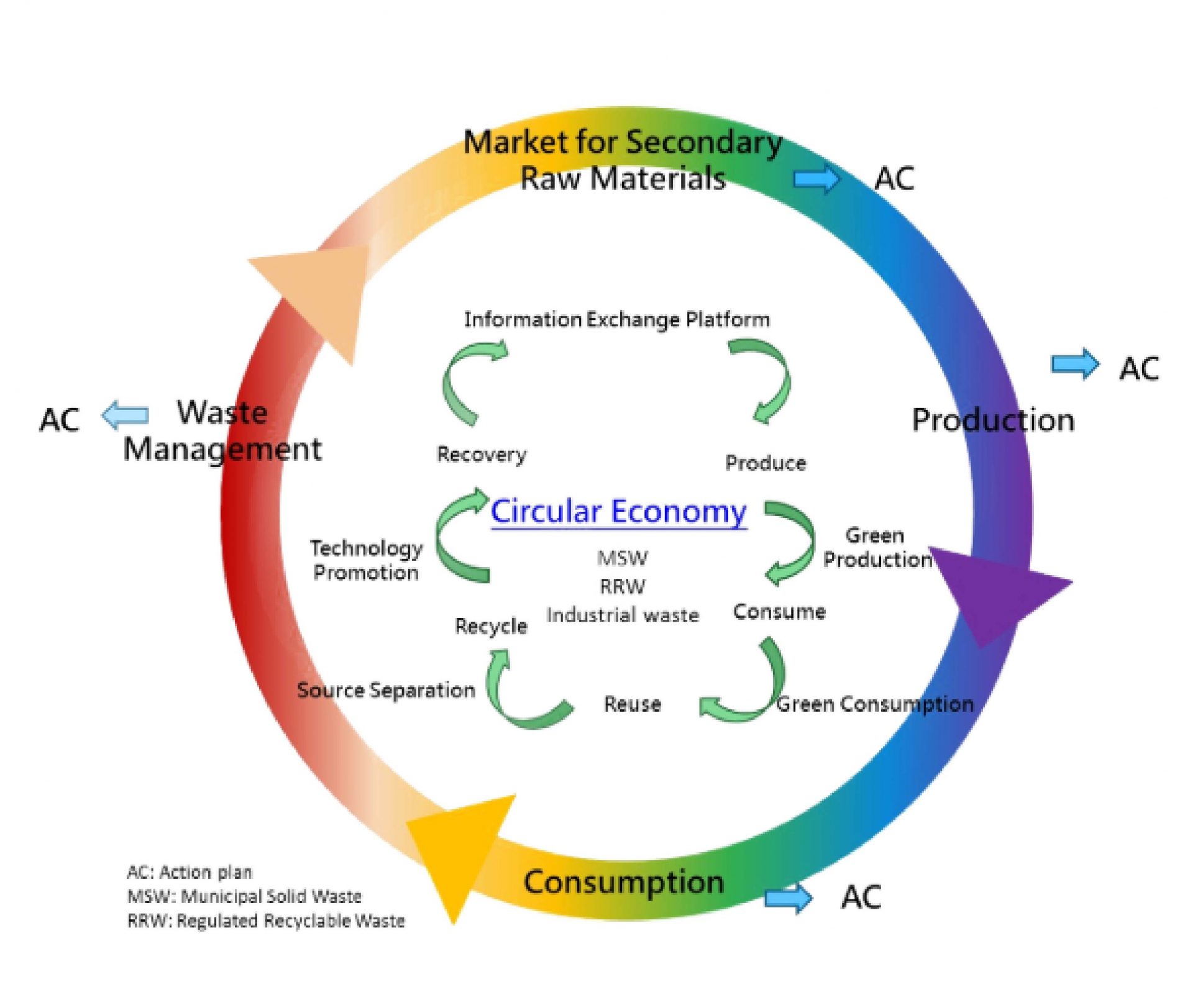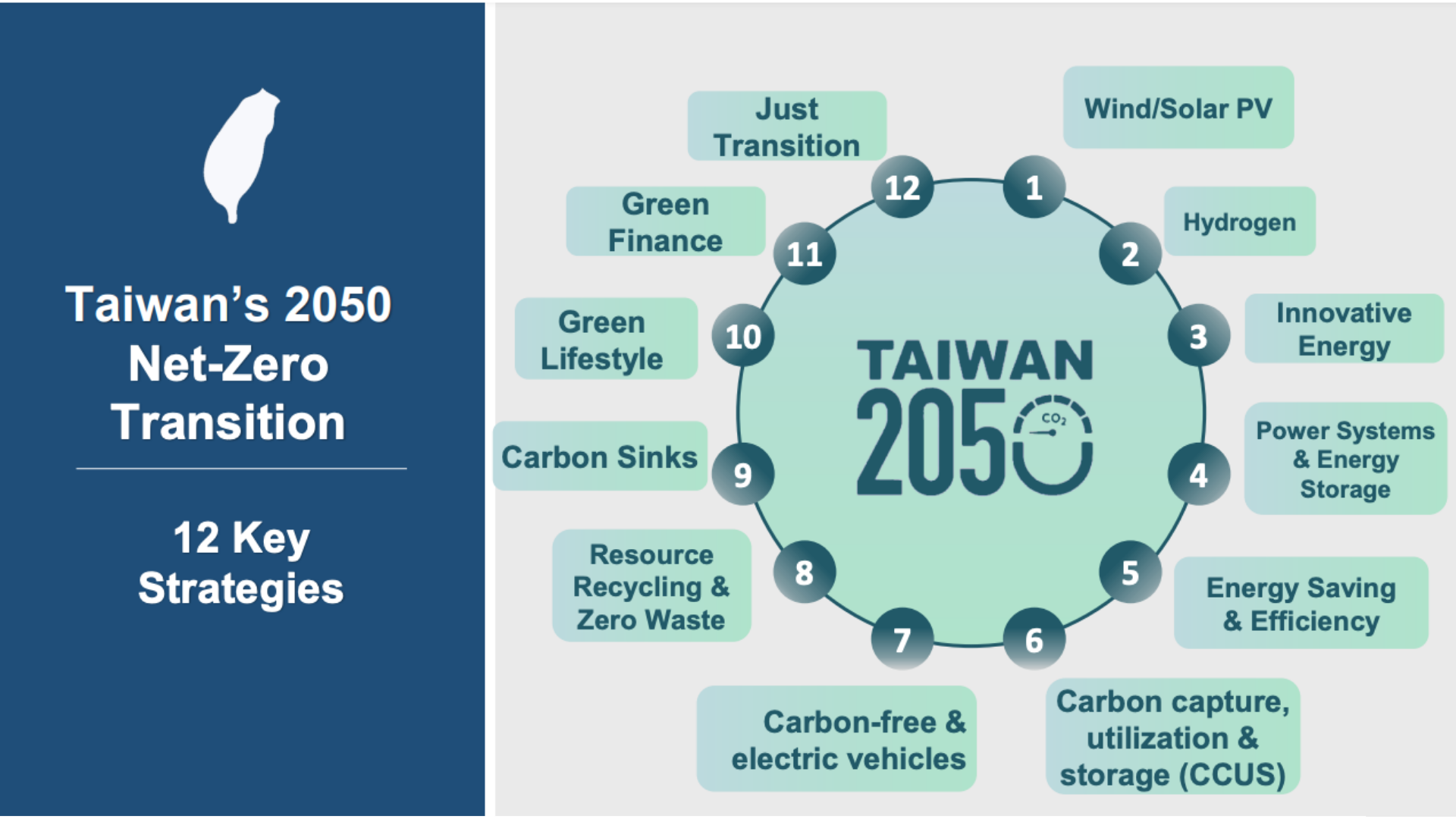The linear economic model has been exhausting resources and generating an increasing amount of waste, threatening to halt economic development and undermine ecological environments around the globe. Since Taiwan is crowded and heavily relies on imported resources, its current linear economic model poses great risks and a key challenge to its transition to a circular economy.
Taiwan occupies a pivotal position in the global supply chain. It leads the world in the IC industry as well as in textile R&D and production. Countless Taiwanese enterprises manufacturing precision machinery play a key role in the operation of many renowned international businesses, therefore winning the title of “hidden champion.” However, behind the pride that comes with the"MIT" (Made In Taiwan) brand are tens of thousands of imported resources, becoming a huge potential problem to Taiwan’s economic development.

Taiwan imports more than 90% of its energy, fertilizers, and feeds and over 60% of its food. Thus, it is essential for Taiwan to increase resource efficiency and recycling by moving towards a circular economy. Meanwhile, companies in Taiwan need to develop new business models to transition from making profits by selling products to providing service, so as to depend less on importing resources, and to, even someday, upgrade their manufacturing businesses to ones with high added values and stop relying on price-cutting. Such a transition will benefit the environment and fulfill the need for a global green supply chain.
In her 2016 inaugural speech, President Tsai Ing-wen pointed out that the circular economy would be crucial for the future development of Taiwan. To transform its economy, Taiwan must become circular. Taiwan has to change its consumption and production models and extract a smaller amount of natural resources, allowing future generations to enjoy the same level of resources available nowadays.
“We must not endlessly expend natural resources and the health of our citizens as we have done in the past. Therefore, we will strictly monitor and control all sources of pollution. We will also bring Taiwan into an age of circular economy, turning waste into renewable resources. We will gradually adjust our energy options based on the concepts of sustainability. The new administration will seriously address issues related to climate change, land conservation and disaster prevention. After all, we only have one earth, and we only have one Taiwan.” —Tsai Ing-wen, ROC 14th-term President
As the concept of circular economy takes root and continues to flourish in Taiwan, Circular Taiwan Network compiles the following list of initiatives by the government of Taiwan to help the community of circular economy understand what has been accomplished and the way forward.

To cultivate economic development and industrial transformation, the government proposed the “5+2 innovative industries” as the core of its industrial policy.
The “5+2” means five industries and two transformation strategies: The five industries include
- Asian Silicon Valley
- Biomedical industry
- Green energy technology
- Smart machine
- National defense industry
the two transformation strategies
- Circular economy
- New agriculture
"Plus 2" is not industry-specific but aims to help every industry to incorporate resource recycling into its strategy and model. The system of circular economy allows resources and products to be preserved at a higher value and repeatedly circulated. New agricultural technology using bio-refinery and cascading to produce the raw materials needed by Taiwan’s industries.
“Five Plus Two” incorporates circular economy into the axis of Taiwan’s industrial policy, making more and more industries pay attention to circular economy. These industries have been exploring how to use the concept of circular economy to upgrade and transform their businesses, breaking away from the linear model that relies on resource consumption to make profits, to increase the added-value of their products, and to become more competitive in the market. “Plus Two” is designed to not only accelerate the upgrade of the five innovative industries in the short term but also drive transformation and re-engineering of all industries in the long term, giving rise to an innovative, sustainable, and circular industrial model.

In 2018, MOEA launched the Circular Economy Promotion Plan. The Plan is based on four strategies and two axes.
The two axes are “circular industrialization” and “Industrial circulation,” while the four strategies include:
- Promote the research and development of circular technologies and material innovation and establish a special zone for this purpose.
- Build demonstration circular parks.
- Promote green consumption and transaction.
- Facilitate energy and resource integration as well as industrial symbiosis.
MOEA wishes to utilize inter-disciplinary methods to solve the dilemma of pursuing industrial or sustainable development and to cultivate talents for circular economy starting in the materials industry, transforming Taiwan’s linear economic model intoto a circular one, so as to create the new momentum for industrial development.
In 2019, MOEA established the Circular economy Promotion Office. The Office coordinates the efforts of ministries, industries, and academia, in charge of “policy coordination” and” resource integration”.
Highlight 1: Industrial Symbiosis
Establishing a resource-exchange mechanism is crucial to implementing the circular model. One factory’s byproducts can be another’s raw materials, preventing a waste of resources. Such a mechanism can be implemented by factories in the same industrial zones or even inter-zonally.
The Bureau of Industry (BOI) under MOEAhas been promoting regional energy and resources Integration for many years. To date, BOI has implemented the integration in 23 industrial zones , and in each case, there is a core industry, including the steel industry, cogeneration power plants, biofuel steam plants, the cement industry, the pulp and paper industry, and the environmental industry. A well-known example is the Linhai Industrial Park in Kaohsiung, where the energy and resource integration has been put into practice by a cluster of the steel and petroleum industries formed around the integration between the businesses of Sinosteel Corporation and CPC Corporation, a state-owned petroleum enterprise.
Waste materials are unidentified resources while the transparency and circulation of information on energy and resources is the foundation for industrial symbiosis. To fill in the gap, BOI has been operating a platform for integration of the information, allowing companies in Taiwan to register and match their supply and demand of by-products.
To increase the benefit, BOI has introduced evaluation metrics for circular parks to understand the status of existing energy and resources integration and to identify opportunities for improvement and further integration in the future.

Highlight 2: circular materials verification and matching platform
This platform is part of the Circular Economy Promotion Plan, aiming to raise the public’s trust in circular materials through transparent management of the materials and a good social communication mechanism.
In response to technological trends, this platform uses technologies such as blockchain, AI, and the Internet of Things (IoT) to reinforce the quality verification of circular materials, to facilitate the matching of demand and supply, so it can accelerate resource integration and create business opportunities. The platform also establishes a database of the baseline information such as specifications from the sources of the materials. and monitors the transportation and reuse stages with information and communication technologies, making sure the quality and flow of the materials allow them to be returned to the industrial system for further reuse.
Highlight 3: Taiwan Circular Economy 100, TCE100
In 2019, MOEA established TCE100, bringing together representatives from the private sector, government, and academia to foster cooperation related to circular economy among different industries. The joint statement by TCE100 has three main points: companies should start transiting towards the circular model, expand cooperation on energy and resources, and work together to build a circular resource system.
To promote circular economy, EPA has developed a resource management strategy, similar to that of the EU, based on the product life cycle model. The strategy aims to maximize the efficiency of resource use and minimize the impact on the environment in all four stages of a product life cycle: production, consumption, waste management, and the market of secondary materials. By doing so, EPA has upgraded its focus from waste to resource management.
Under the framework of waste management, the recycling rate is an important indicator to measure policy effectiveness. On the contrary , resource management emphasizes not only recycling or the optimization of a single aspect but an overhaul of the resource system. EPA uses “resource productivity” and “cyclical use rate” to indicate the effectiveness of its resource management strategy. In 2020, Taiwan scored 76.36 NTD per kilogram of resource in productivity and 20.53% in cyclical use, the latter meaning that about 20% in each unit of resource input was circular.

Highlight 1: Metrics and analytics system for resource circulation
Understanding how resources are used on the national level is the first step to increase resource productivity and cyclical use. EPA has established metrics and an analytics system to integrate data across government departments. The system categorizes resources into four groups, including metal, non-metal, bio-kind, and bio-fuel, and records each year’s input, consumption, emission, and recovery levels. Doing so helps the government, industry, and public to understand how national resources are used in Taiwan. Also, when the government needs to create strategies for resource management, the data can serve as evidence.
Highlight 2: Four-in-one recycling program
Under the framework of sustainable resource management, it is essential to turn waste into secondary materials, so the materials can keep being utilized in the industrial system. In 1988, EPA established the Recycling Fund Management Board to involve citizens, local cleaning teams, recycling enterprises, and recycling funds in recycling through the four-in-one recycling program. The program collects fees from manufacturers and importers to set up a recycling fund that pays for the recycling service of local cleaning teams, recycling enterprises. This policy boosted Taiwan’s recycling rate ten folds, from 5.8% in 1998 to 55.14% in 2019.
Besides managing waste, the Board has also developed an incentive policy from the perspective of product design. Depending on the total amount of secondary materials used in products, producers and importers pay different rates to the recycling fund, incentivizing them to introduce environmental-friendly products that can be easily dismantled, recycled, and contain certain amounts of secondary materials.
The key to the transition from a linear to a circular economy is that companies need to adopt the circular model. Meanwhile, government policies can guide and support companies in the process; thus, policy resources also need to align with the concept of circular economy.
As the international community has been paying more and more attention to circular economy, those countries relying heavily on imported resources have been especially looking for ways to boost efficiency with a smaller amount of resources. How to create policies to support the transition towards a circular economy has been an important issue for governments to exchange views on.
The design of policies aligning with circular economy takes carrots and sticks at the same time. Such policies need to not only incentivize enterprises to adopt the circular but also, via the rule of law, set higher circular standards for the enterprises to achieve in the long run.
Looking at the world through the glasses of circular economy will make people realize that opportunities to promote circular economy through policies are everywhere. On the one hand, in areas such as updates of a regulation or education system, it takes more time to see the effects of policies. On the other hand, economic incentives, such as circular procurement and green recovery, might bring about immediate results in the short term.
